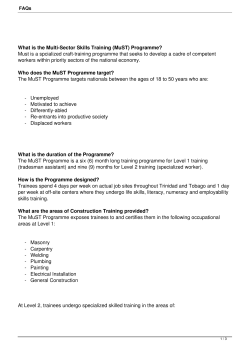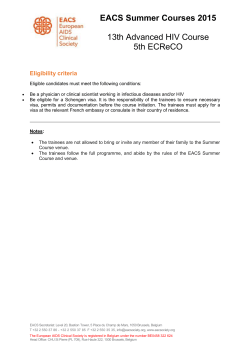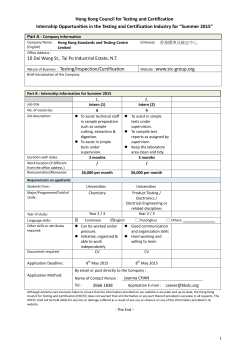
Undergraduate Training Brochure
Financial Modeling Certification (“FMC”) Program Undergradute Students 1 “ I found the FMC Program broke down the financial model into really understandable portions, allowing for greater depth of learning than traditional methods. Additionally, many of the shortcuts greatly improved my Excel efficiency. “ ” Participating in Adventis CG’s Financial Modeling Course allowed me to fine-tune my financial modeling skills. The program refined my excel skills as well as helped me learn the proper way to build a thorough financial model. These skills have paid dividends in both course work and at my work site. The instructors are very knowledgeable and are willing to help students on an individual level. Overall, the FMC Program was a great investment of both my time and money. I would highly recommend it to anybody who wants to excel in the financial industry. “ ” I could see my Excel skills greatly improve. I was able to navigate around Excel without the mouse and use shortcuts by creating my own macros. This was valuable in the workplace because I was able to teach my older and more experienced coworkers new things. My new skills were also valuable in interviews because companies were interested in advanced Excel skills. Along with my interest in investment banking modeling, I found the program very fulfilling. “ “ “ ” I truly enjoyed this program as it gave a very in-depth look at financial modeling. It was much easier to see where everything was flowing and why certain things are calculated the way they are. ” I have never learned so much about a possible career in one day. ” Adventis CG’s FMC Program is a fantastic program that does not just teach you key strokes and best practices but what drives the numbers. ” Adventis CG offers professionals and undergraduates a better way to acquire vital financial modeling skills through its Financial Modeling Certification (“FMC”) Program. The FMC Program uses a superior approach to teaching that combines in-person, “learn by doing” instruction with self-paced learning. Our courses consist of trainees building three statement financial models and other analyses completely from “scratch”. No other program offers in-person, real-world application and hands-on training like Adventis CG. The Adventis CG team consists of individuals with experience in investment banking, private equity, consulting, corporate lending and asset management. 2 Table of Contents FMC Program Overview . . . . . . . . . . . . . . . . . . . . . . . . . . . . . . . . . . . . . . . . . . . . . . . . . . . 4 Our Certifications . . . . . . . . . . . . . . . . . . . . . . . . . . . . . . . . . . . . . . . . . . . . . . . . . . . . . . . . 5 FMC Program Timeline . . . . . . . . . . . . . . . . . . . . . . . . . . . . . . . . . . . . . . . . . . . . . . . . . . . . 6 FM Level I Certification . . . . . . . . . . . . . . . . . . . . . . . . . . . . . . . . . . . . . . . . . . . . . . . . . . . . 7 FM Level II Certification . . . . . . . . . . . . . . . . . . . . . . . . . . . . . . . . . . . . . . . . . . . . . . . . . . . 8 Self-Paced Exercise . . . . . . . . . . . . . . . . . . . . . . . . . . . . . . . . . . . . . . . . . . . . . . . . . . . . . . . . 9 Financial Modeling Macros & Keyboard Shortcuts . . . . . . . . . . . . . . . . . . . . . . . . . . . . . . 10 Course Packet . . . . . . . . . . . . . . . . . . . . . . . . . . . . . . . . . . . . . . . . . . . . . . . . . . . . . . . . . . . 11 Financial Modeling Course . . . . . . . . . . . . . . . . . . . . . . . . . . . . . . . . . . . . . . . . . . . . . . . . 12 Valuation Course . . . . . . . . . . . . . . . . . . . . . . . . . . . . . . . . . . . . . . . . . . . . . . . . . . . . . . . . 13 Leveraged Buyout Course . . . . . . . . . . . . . . . . . . . . . . . . . . . . . . . . . . . . . . . . . . . . . . . . . . 14 Resume & LinkedIn Profile . . . . . . . . . . . . . . . . . . . . . . . . . . . . . . . . . . . . . . . . . . . . . . . . 15 3 FMC Program Overview Undergradute Training Overview The job market is becoming more competitive each year. Candidates for internships and entry-level financial analyst positions are expected to bring more skills to the job than ever before. Through our FMC Program, we offer certifications that give undergraduate students an incredibly valuable set of analytical skills which they can use to differentiate themselves. Students are taught and certified by former investment banking and private equity professionals. Certified students have participated in two full-day, instructor-led courses and practiced their financial modeling skills outside of the courses, typically for a total of 30-50 hours. Certified students have been vetted as having mastered the fundamental financial modeling and valuation skills required to excel in demanding and fast paced work environments. The undergraduate students who find the most value in our FMC Program are those that aspire to have careers in investment banking, private equity, corporate finance and other finance-related fields. Overview The Financial Modeling Certification (“FMC”) Program is offered to professionals and undergraduate students looking to transition theories and concepts into real-world financial modeling skills. The FMC Program uses a superior approach to teaching financial modeling skills that combines in-person, “learn by doing” instruction with self-paced learning and enables trainees to build a set of highly valuable skills that will enhance their careers in investment banking, private equity, corporate finance and other finance-related fields. Our courses consist of trainees building best-of-class, three-statement financial models and other analyses entirely from “scratch”, while selectively using lecture-based instruction to explain concepts along the way. Concepts covered in our courses include financial modeling, accounting, corporate finance, intrinsic and relative valuation and leveraged buyout transactions. Benefits of our Certifications Adventis CG has fostered valuable relationships with over 50 investment banking and corporate employers. Each of these employers has recognized the value of their certifications and they have already begun to ask for candidates for part-time, internship and full-time positions. Students who have been awarded our FM Level I Certification or FM Level II Certification will join our invitation-only LinkedIn group, where they will get access to these opportunities and mentorship and resume critiques from our Lead Trainers. 4 Our Certifications Overview The FMC Program consists of two certifications that require trainees to pass a rigorous and thorough set of requirements that demonstrate they have strong analytical capabilities and an understanding of key concepts. Financial Modeling (“FM”) Level I Certification The Financial Modeling (“FM”) Level I Certification sets trainees apart that have learned best-of-class financial modeling skills and internalized key financial modeling, accounting and corporate finance concepts. This certification requires trainees to build a best-of-class, three statement financial model from “scratch” in less than 90 minutes and score at least 90% on a 30 question multiple-choice exam. Financial Modeling (“FM”) Level II Certification The Financial Modeling (“FM) Level II Certification sets trainees apart that have internalized key valuation and leveraged buyout concepts, in addition to having earned our FM Level I Certification. This certification requires trainees to score at least 90% on a 25 question multiple-choice exam. FM Level I Certification Skills & Concepts Overview of Exams Exams Basic financial modeling skills ■ Excel keystrokes ■ Financial modeling exam Muliple choice exam (90%) ■ FM Level II Certification Valuation ■ Leveraged buyout transactions ■ Muliple choice exam (90%) ■ ■ Corporate finance Other analyst positions Investment banking Private equity ■ ■ ■ ■ 5 FMC Program Timeline Campus Presence For each undergraduate university in which we are present, we offer one day of instruction per semester. During the fall semester this day typically occurs between late September and early November. During the spring semester this day typically occurs between early February and early May. In order to qualify for either the FM Level I Certification or FM Level II Certification, trainees are required to participate in two days of instruction. On-Campus Instruction Each day of instruction lasts approximately six hours and begins with the Financial Modeling Course, which typically lasts four hours. Trainees build a financial model for a different company each semester. The second part of the day rotates between the Valuation Course and the Leveraged Buyout Course. Exams for FM Level I Certification and FM Level II Certification are offered to qualified candidates at the conclusion of each instructorled session. Testing for FM Level I Certification typically lasts two hours and testing for FM Level II Certification typically lasts thirty minutes. Component Semester One 1. Self-Paced Exercise ■ Basic financial modeling skills ■ Excel keystrokes 2. Instructor-Led Session ■ Financial Modeling Course ■ Valuation Course 3. Practice ■ Practice financial modeling exercise ■ Study and internalize the course packet Semester Two 4. Instructor-Led Session ■ Financial Modeling Course ■ Leveraged Buyout Course 5. Certification Exams ■ FM Level I Certification ■ FM Level II Certification Completion Time 1-5 Hours 6 Hours 15-30 Hours 6 Hours 2-3 Hours 30-50 Total Hours 6 FM Level I Certification Overview Our Financial Modeling (“FM”) Level I Certification sets trainees apart that have learned best-of-class financial modeling skills and internalized key financial modeling, accounting and corporate finance concepts. Candidacy for FM Level I Certification In order to be a candidate for FM Level I Certification, trainees must have participated in both days of instruction within our FMC Program. For undergraduate students, this can be done by attending two days of instruction on–campus. For professionals, this can be done by attending one of our Public Boot Camps. We believe that there is no substitute to learning the skill of financial modeling through repetition and this Our FM Level I Certification sets students apart that have learned best-ofclass financial modeling skills and internalized key financial modeling, accounting and corporate finance concepts. certification requires trainees to practice their financial modeling skills and internalize key concepts. Certification Exams In order to be awarded the FM Level I Certification, trainees must pass a financial modeling exam and a multiple-choice exam. The In honor of your outstanding performance and dedication we gladly present this certificate of completion to: Bob Smith financial modeling exam is similar to the exercise in the Financial for completing all the requirements for FM Level I Certification Modeling Course in that trainees are required to build a best-of-class, three statement financial model from “scratch”. However, trainees awarded on June 28, 2014 L dT Lead Trainer i L dT Lead Trainer i do not receive instruction from trainers when taking the exam. We have a rigorous set of criteria for passing trainees on this exam, which includes completion within 90 minutes, accurate formulas and proper formatting. The multiple-choice exam includes 30 questions and is focused on financial modeling, accounting and corporate finance concepts. Successfully answering 90% of the questions on this exam is required to demonstrate a fundamental understanding of the topics at hand and become certified. 7 FM Level II Certification Overview Our Financial Modeling (“FM) Level II Certification sets trainees apart that have internalized key valuation and leveraged buyout concepts, in addition to having earned our FM Level I Certification. Candidacy for FM Level II Certification In order to be a candidate for FM Level II Certification, trainees must have been awarded the FM Level I Certification. We make our FM Level I Certification a pre-requisite for this certificate because we believe Our FM Level II Certification sets students apart that have internalized key valuation concepts, in addition to having earned our FM Level I Certification. trainees should have a basic understanding of key financial modeling, accounting and corporate finance concepts before learning more advanced concepts. Certification Exams In order to be awarded the FM Level II Certification, trainees must pass a multiple-choice exam. The exam includes 25 questions and is focused on valuation and leveraged buyout concepts. Successfully answering 90% of the questions on this test demonstrates a student has a fundamental understanding of the topics at hand and is required to become certified. In honor of your outstanding performance and dedication we gladly present this certificate of completion to: Bob Smith for completing all the requirements for FM Level II Certification awarded on June 28, 2014 L dT Lead Trainer i L dT Lead Trainer i 8 Self-Paced Exercise Overview One of the unique characteristics of the FMC Program is our requirement that trainees complete our Self-Paced Exercise in advance of their first instructor-led course. This exercise is designed to teach trainees best-of-class formatting techniques and Microsoft Excel keystrokes. This approach enables trainees to focus almost exclusively on learning concepts related to financial modeling during the instructor-led components of the FMC Program. The Self-Paced Exercise is the primary reason we are able to administer our courses in four hours or less. Exercise Description Upon enrollment in the first day of instruction, trainees receive the Pre-Course Packet, Adventis CG’s Financial Modeling Macros, the Self-Paced Exercise and instructions on how to complete the Self-Paced Exercise. The Self-Paced Exercise is a Microsoft Excel file with two tabs. The first tab is not formatted and the second tab is properly formatted. Trainees must format the first tab so that it is identical to the second tab. The first time trainees perform this exercise it takes them approximately 20-30 minutes. With subsequent repetition of this exercise they are able to make incremental improvements and eventually complete the exercise within five minutes. On average it takes trainees 1-5 hours before they can complete this exercise within five minutes. Before After 9 Financial Modeling Macros and Keyboard Shortcuts Financial Modeling Macros Adventis CG’s Financial Modeling Macros (“Macros”) are contained in an Excel file. The Macros are mandatory for all components of the FMC Program. They enable trainees to be significantly more efficient in Microsoft Excel and enhance their learning curve in regards to building financial models. Trainees must have the Macros open while working on the Self-Paced Exercise and attending courses in the FMC Program. Keyboard Shortcuts Learning how to use a computer with limited use of the mouse is critical for efficiency in financial modeling, as well as navigating other computer applications. Our Pre-Course Packet contains the most critical keyboard shortcuts. Learning these keyboard shortcuts will be critical to successfully completing the FMC Program. 10 Course Packet Overview Trainees receive an electronic copy of the Course Packet when they enroll in their first day of instruction on campus. The Course Packet includes all the information trainees need to prepare for the first day of instruction, as well as all the concepts they will need to know in order to earn their FM Level I Certification and FM Level II Certification. The following is the Table of Contents of the Course Packet. Table of Contents The Basics I. Adventis CG’s Financial Modeling Macros II. Keyboard Shortcuts III. Overview of the Financial Statements IV. Financial Ratios Financial Modeling (“FM”) Level I Certification V. Overview of Financial Modeling VI. Adventis CG’s 10-Step Financial Modeling Method VII. Checklist for the Financial Modeling Exam VIII. Financial Modeling (“FM”) Level I Certification Scorecard Financial Modeling (“FM”) Level II Certification IX. Overview of Valuation Concepts X. Overview of Leveraged Buyout Concepts XI. Financial Modeling (“FM”) Level II Certification Scorecard Other Information XII. Student Trainer Program XIII. Frequently Asked Questions – FMC Program XIV. Frequently Asked Questions – Interviews 11 Financial Modeling Course Overview The Financial Modeling Course is one of the core components of the FMC Program. It typically lasts approximately four hours. During this course, trainees build a fully circular, three-statement financial model Rather than receive pre-constructed templates, trainees build all The Financial Modeling Course is the foundation for the FMC Program. formulas from “scratch”, which enables them to truly understand why and how the formulas work. Trainees follow Adventis CG’s 10-Step Program to build their financial model, under the guidance of our Lead Trainers. Trainees are able to learn the concepts behind the work performed, as trainers take time to elaborate after each step. Course Description Trainees receive a 9-tab blank spreadsheet which they use to build the financial model. They also receive another spreadsheet with three years of historical information and five years of projection inputs. Finally, trainees receive select pages from the company’s 10-K so they get a feel for where the data came from. During this course trainees: Build income statement, balance sheet and cash flow statement projections ■ Use inputs to drive revenue, expenses, taxes, capital expenditures, depreciation and other metrics ■ Build supporting schedules for equity, fixed assets, working capital, capital structure, debt and interest expense ■ Build corporate finance schedules for dividends, share repurchases and common shares ■ 12 Valuation Course Overview The Valuation Course is designed for trainees that have already participated in our Financial Modeling Course. It typically lasts approximately two hours. This course enables trainees to extend their financial modeling skills to valuation concepts. Rather than receive preconstructed templates, trainees build the formulas from “scratch” which enables them to learn why and how the formulas work. The Valuation Course enables students to extend their financial modeling skills to valuation concepts. In this course trainees use the financial model they have built in the Financial Modeling Course as a starting point. Trainees value the company by building a discounted cash flow (DCF) analysis and a summary valuation analysis (or “football field”) from “scratch”. Course Description Trainees receive a 2-tab blank spreadsheet which they copy into the financial model they’ve built in the Financial Modeling Course. During this course trainees: Calculate the present value of the projection period ■ Determine terminal value using the perpetuity growth rate method ■ Determine terminal value using the exit multiple method ■ Value the company by comparing the results of the discounted cash flow analysis with trading comparables, transaction comparables and the current stock price of the company in a summary valuation analysis (or “football field”) ■ 13 Leveraged Buyout Course Overview The Leveraged Buyout Course is designed for trainees that have already participated in our Financial Modeling Course. It typically lasts approximately two hours. The Leveraged Buyout Course enables trainees to use their financial modeling skills to learn key concepts around transaction value, sources and uses of funds and investor returns. Rather than receive a template with pre-constructed formulas, trainees build formulas from “scratch” which enables them to learn why and how the formulas work. In this course trainees use the financial model they have built in the Financial Modeling Course as a starting point. Trainees build a basic The Leveraged Buyout Course enables students to use their financial modeling skills to learn key concepts around transaction value, sources and uses of funds and investor returns. leveraged buyout analysis from “scratch”. Course Description Trainees receive a 1-tab blank spreadsheet which they copy into the financial model they’ve built in the Financial Modeling Course. During this course trainees: Determine the appropriate acquisition premium and resulting transaction value of a potential buyout ■ Build a sources and uses of capital schedule for the transaction ■ Determine the optimal capital schedule for the transaction ■ Build a debt pay down schedule ■ Determine appropriate exit assumptions ■ Calculate resulting investor returns ■ 14 Resume & LinkedIn Profile Overview We have strict rules regarding what trainees are allowed to put on their resumes, LinkedIn profiles or other social media in regards to participating in our FMC Program. When employers see our FM Level I Certification or FM Level II Certification on trainees’ resumes or profiles we want them to understand their underlying value. Participation Only If a trainee has participated in one or several of the instructor-led courses in our FMC Program but has not earned one of our certifications, he or she may use one or all of the following bullet points: Enrolled in Adventis CG’s Financial Modeling Certification Program ■ Attended the Financial Modeling Course, Valuation Course and/or Leveraged Buyout Course FM Level I Certification If a trainee has been awarded our FM Level I Certification, he or she may use one or all of the following bullet points: Financial Modeling Level I Certification from Adventis CG (awarded Month Year) ■ ■ Built a three-statement, fully circular and properly formatted financial model from “scratch” in under 90 minutes Developed an understanding of key concepts in financial modeling, accounting and corporate finance FM Level II Certification If a trainee has been awarded our FM Level II Certification, he or she may use one or all of the following bullet points: Financial Modeling Level II Certification from Adventis CG (awarded Month Year) ■ ■ Built a three-statement, fully circular and properly formatted financial model from “scratch” in under 90 minutes Developed an understanding of key concepts in financial modeling, accounting, corporate finance, intrinsic and relative valuation and leveraged buyout transactions 15
© Copyright 2025









